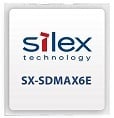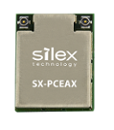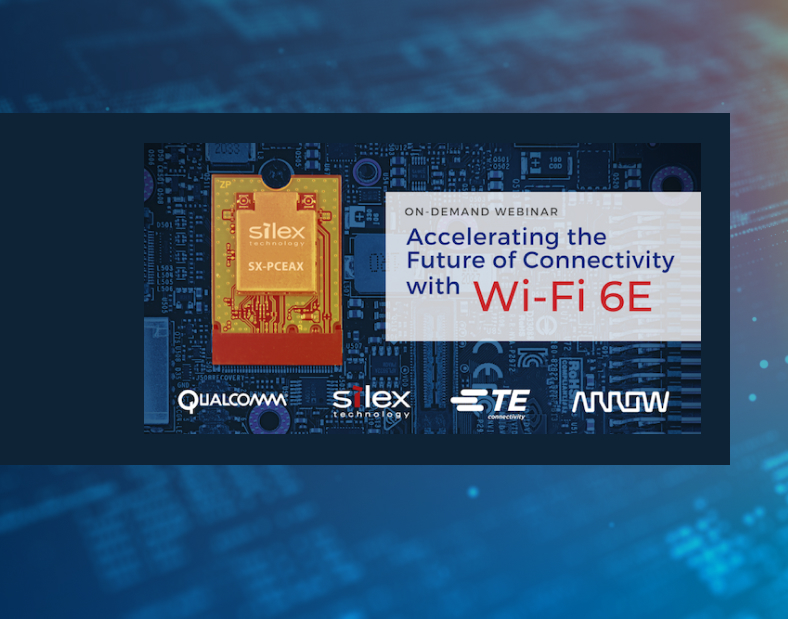Wi-Fi 6E: Faster, Secure,
Wireless Technology
Next Generation Wi-Fi 6E Plus Bluetooth PCIe Combo Module

SX-SDMAX6E
Tri-band Wi-Fi 6E plus Bluetooth® Combo SDIO Module
- 6 GHz Band Support for Stable, Interference-Free Connectivity
- Boost Battery-Powered Devices with Speed and Efficiency
- Seamless Migration with SX-SDMAX6E

SX-PCEAX
Wi-Fi 6E + Bluetooth 5.2 PCI Radio Module
- Industry's 1st tri-band Wi-Fi 6E module
- Supports dual band simultaneous operation
- Multiple form factors

SX-PCEAX-AP6E
Wi-Fi 6E Access Point Module
- Offers tri-band connectivity
- Standard form factor for easy integration
- Faster speeds, lower latency
What is 6GHz Wi-Fi?
Until now, Wi-Fi operated on two bands: 2.4 GHz and 5 GHz. The Wi-Fi 6 standard employs various features to improve the efficiency and data throughput of your wireless network and reduce latency for those two bands.
Wi-Fi 6E extends the capacity, efficiency, coverage, and performance benefits of Wi-Fi 6 into the 6-GHz band. With up to seven additional super-wide 160-MHz channels available, 6GHz capable devices deliver greater network performance and support more Wi-Fi users at once, even in very dense and congested environments.
.png)
The Impact of Wi-Fi 6E, an Interview with Qualcomm

Accelerating the Future of Connectivity to Wi-Fi 6E

Wi-Fi 6E: Wi-Fi in the 6GHz band
This paper by Wi-Fi Alliance shares Wi-Fi 6E's economic and technical benefits and provides a general overview of its capabilties.
Frequently Asked Questions
What is the difference between Wi-Fi 6E & Wi-Fi 6, what are the benefits of Wi-Fi 6E?
So in summary, Wi-Fi 7 can be the best solution for throughput and latency but with a high cost for a high band simultaneous to achieve it (5+ 6G co-existence). On the other hand, Wi-Fi 6E is good running in 6GHz w/o much cost adder compared to Wi-Fi 6. So, customers can choose a better solution as Wi-Fi 6E or the best solution as Wi-Fi 7.
Could you share the product information of the Wi-Fi 6E including the roadmap and module?
What does Wi-Fi 6E and 5G integration look like?
Businesses have leveraged multiple technologies in the past, we believe that the industry will use both 5G and Wi-Fi 6E in much the same way. The new higher frequency deployment options will require more radios and access points to cover the same areas, as the higher frequency signals do not provide the same coverage as lower frequency equipment. Wi-Fi 6E is a cost-effective solution for networks and provides high bandwidth connectivity, but it does not guarantee the first-time successful delivery of data. Wi-Fi 6E is a good option for high-bandwidth networks that can endure some latency caused by retransmitting packets through the network. Wi-Fi 6E is undoubtedly an excellent indoor option for use cases that need best-effort connectivity, many of today’s applications have strict latency requirements that may demand tightly managed quality of service levels which may be available with 5G.
How will it (Wi-Fi 6E) improve the experience of VoWi-Fi (Voice over Wi-Fi)?
Does Wi-Fi 6 have any provision for wireless video?
What is the difference between Wi-Fi 6E and Wi-Fi 6, what are the benefits of Wi-Fi 6E?
What's he cost gap between Wi-Fi 6 and Wi-Fi 6E solutions from a module point of view since we understand the benefit of using Wi-Fi 6E now?
How can you integrate Wi-Fi 6E with 60Ghz?
These are two different wireless technologies, 802.11ax and 802.11ad that operate in completely two different frequency bands (6GHz and 60Ghz) and don’t overlap. So its not a question about integration but more about co-existence. Yes, these two technologies can co-exist with one another. They will have their own separate networks.
In terms of speed Wi-Fi 6E & 60Ghz have in common?
Does Wi-Fi 6 have any provision for wireless video?
Does SX-PCEAX support monitor mode?
What if any impact on the range using Wi-Fi 6E?
The Host interface for Wi-Fi is PCIe3.0. Can the device work with PCIe2.0 Host too?
It will work but is not truly backward compatible. It will work with limited throughput. The base driver is set up to use PCIe 3.0, so driver config modification is required to make this work.
Does SX-PCEAX support AP and STA Simultaneous operation?
Is there an App Note that explains this feature? And how to implement a design from both the hardware and software perspective?
Does the SX-PCEAX require any additional certification after integration?
SX-PCEAX has modular certifications for FCC/IC (North America), CE (Europe) and MIC (Japan). That means that customers using SX-PCEAX do not require any regulatory testing (if they use our module with our certified antennas) for the radio for these particular regions. If you have your own antenna that you wish to use please discuss it with Silex so we can make sure if it can be covered by our certifications.
The customer may need to file for the product level certification, but nothing is required for the Silex module. At Silex, we provide our customers with our certification services to save them time. We have relationships with the regulatory labs and can easily assist in getting products certified and manage the whole process which could be cumbersome. We have a white paper that you can refer to learn what is required to get through regulatory certifications. Also, if you wish to sell your product in countries not covered by our modular certification we can help you get the required testing and approvals so you can sell your products in those particular countries like China, Brazil, Korea, etc.
Master Specialist FO Wireless at Phoenix Contact
Why Silex?
Wireless expertise
Our Wi-Fi and Bluetooth expertise honed over 20 years and exclusive access to Qualcomm technology helps you develop the most reliable solutions.

